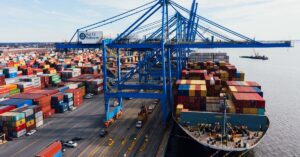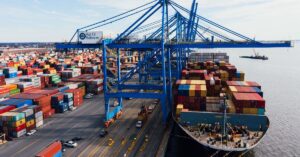
Deadly Storm Hits Cruise Ship In Bay Of Biscay, Leaving 1 Dead & 100 Injured
October 30, 2024
Nuclear-Powered LNG Carriers Promise Faster & Emission-Free Future For Shipping
October 30, 2024

The Biden-Harris Administration announced a nearly $3 billion investment to fund 55 projects under the Environmental Protection Agency’s (EPA) Clean Ports Program.
The initiative aims to install zero-emission equipments, infrastructure upgrades, and climate-focused planning projects in 27 states and territories.
The goal is to reduce diesel pollution at ports, promote environmental justice and provide well-paid union jobs.
EPA Administrator Michael Regan said this historic investment aligns with the administration’s long-term economic goals. He also highlighted the program’s potential to take the U.S. to new heights in clean technology at ports.
The funds come from the Inflation Reduction Act, the largest climate-related investment in U.S. history. This act focuses on decarbonizing various sectors to combat climate change.
The projects in the program will replace traditional port equipment, such as cargo handling tools with cleaner, locomotives, trucks, and zero-emission alternatives.
These upgrades are expected to prevent over 3 million metric tons of carbon pollution, which is equal to the annual energy consumption of over 3,90,000 homes.
The EPA stated that the program aligns with national goals for a zero-emission freight sector under the National Zero-Emission Freight Corridor Strategy.
The Port Authority of New York and New Jersey (PANYNJ) will receive about $344 million to deploy electric cargo-handling equipment, drayage trucks and shore power systems.
Meanwhile, the Port of Baltimore will receive $147 million in funding. Maryland Senator Ben Cardin says the program will reduce emissions, improve air quality, and generate clean energy jobs for the Baltimore region.
The Detroit/Wayne County Port Authority will receive around $22 million to begin a zero-emission transition with battery-electric cargo equipment, solar arrays, and charging infrastructure.
The Port of Oakland will spend $322 million in California to install electric and hydrogen-powered equipment.
This initiative will also involve the scrappage of diesel-powered equipment and community engagement efforts focused on workforce training. The program also involves planning-focused initiatives.
For example, Port Houston in Texas will receive $3 million to develop a comprehensive emissions reduction and climate resilience strategy, while the Puerto Rico Ports Authority will work on a climate resiliency plan to protect infrastructure from hurricane impacts.
John Podesta, Senior Advisor to the President for International Climate Policy, says this initiative reflects the administration’s goal of establishing a sustainable economy while combating pollution in historically impacted regions.
Ali Zaidi, White House National Climate Advisor, said that the Clean Ports Program shows how environmental and economic policies can work together to provide immediate health and financial advantages to communities near ports.
In a statement, the EPA confirmed that the Clean Ports Program grant applications were thoroughly reviewed for workforce development components, assuring that projects will increase access to quality jobs.
The program’s focus on zero-emission freight aligns with the Biden-Harris administration’s goal to lead the global clean energy transition while prioritizing environmental justice for pollution-affected communities.
Reference: U.S EPA
U.S. Invests Historic $3 Billion To Fund 55 Projects Under Clean Ports Program appeared first on Marine Insight – The Maritime Industry Guide
Source: Maritime Shipping News


